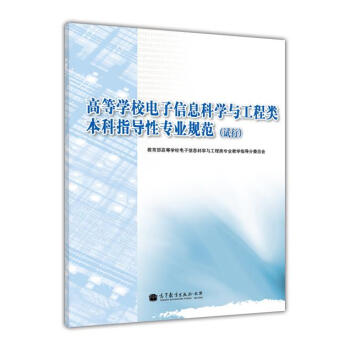![中外物理学精品书系·引进系列(23)·光子晶体光纤:特性及应用(影印版) [Photonic Crystal Fibers]](https://pic.qciss.net/11305541/rBEhVlIdZB8IAAAAAALGZ6quGCYAACj0gDxbqkAAsZ_918.jpg)

具体描述
内容简介
《中外物理学精品书系·引进系列(23)·光子晶体光纤:特性及应用(影印版)》内容丰富,涵盖面广,可读性强,其中既有对我国传统物理学发展的梳理和总结,也有对正在蓬勃发展的物理学前沿的全面展示;既引进和介绍了世界物理学研究的发展动态,也面向国际主流领域传播中国物理的优秀专著。内页插图
目录
PrefaceAcknowledgements
Introduction
1 Basics of photonic crystal fibers
1.1 From conventional optical fibers to PCFs
1.2 Guiding mechanism
1.2.1 Modified totalinternal reflection
1.2.2 Photonic bandgap guidance
1.3 Properties and applications
1.3.1 Solid-core fibers
1.3.2 Hollow-core fibers
1.4 Loss mechanisms
1.4.1 Intrinsic loss
1.4.2 Confinement loss
1.4.3 Bending loss
1.5 Fabrication process
1,5.1 Stack-and-draw technique
1.5.2 Extrusion fabrication process
1.5.3 Microstructured polymer optical fibers
1.5.4 OmniGuide fibers
1.6 Photonic crystal fibers in the market
Bibliography
2 Guiding properties
2.1 Square-lattice PCFs
2.1.1 Guidance
2.1.2 Cuto:ff
2.2Cutoff of large-mode area triangular PCFs
2.3 Hollow-core-modified honeycomb PCFs
2.3.1 Guidance andleakage
2.3.2 Birefringence
Bibliography
3 Dispersion properties
3.1 PCFs for dispersion compensation
3.2 Dispersion of square-lattice PCFs
3.3 Dispersion-fl.attened triangular PCFs
3.3.1 PCFs with modified air-hole rings
3.3.2 Triangular-core PCFs
Bibliography
4 Nonlinear properties
4.1 Supercontinuum generation
4.1.1 Physics of supercontinuum generation
4.1.2 Highly nonlinear PCFs
4.1.3 Dispersion properties and pump wavelength
4.1.4 Infiuence of the pump pulse regime
4.1.5 Applications
4.2 Optical parametric amplification
4.2.1 Triangular PCFs for OPA
4.2.2 Phase-matching condition in triangular PCFs
4.3 Nonlinear coefficient in hollow-core PCFs
Bibliography
5 Raman properties
5.1 Raman effective area and Raman gain coefficient
5.2 Raman properties of triangular PCFs
5.2.1 Silica triangular PCFs
5.2.2 Tellurite triangular PCFs
5.2.3 Enlarging air-hole triangular PCFs
……
6 Erbium-doped fiber amplifiers
A Finite Element Method
精彩书摘
1.3.1 Solid-core fibersIndex-guiding PCFs, with a solid glass region within a lattice of air-holes, offer a lot of new opportunities, not only for applications related to fundamental fiber optics. These opportunities are related to some special properties of the photonic crystal cladding, which are due to the large refractive index contrast and the two-dimensional nature of the microstructure, thus affecting the birefringence, the dispersion, the smallest attainable core size, the number of guided modes and the numerical aperture and the birefringence. Highly birefringent fibers Birefringent fibers, where the two orthogonally polarized modes carried in a single-mode fiber propagate at different rates, are used to maintain polarization states in optical devices and subsystems. The guided modes become birefringent if the core microstructure is deliberately made twofold symmetric, for example, by introducing capillaries with different wall thicknesses above and below the core. By slightly changing the air-hole geometry, it is possible to produce levels of birefringence that exceed the performance of conventional birefringent fiber by an order of magnitude. It is important to underline that, unlike traditional polarization maintaining fibers, such as bow tie, elliptical-core or Panda, which contain at least two different glasses, each one with a different thermal expansion coefficient, the birefringence obtainable with PCFs is highly insensitive to temperature, which is an important feature in many applications. An example of the cross-section of a highly birefringent PCF is reported in Fig. 1.6.
Dispersion tailoring
The tendency for different light wavelengths to travel at different speeds is a crucial factor in the telecommunication system design. A sequence of short light pulses carries the digitized information. Each of these is formed from a spread of wavelengths and, as a result of chromatic dispersion, it broadens as it travels, thus obscuring the signal. The magnitude of the dispersion changes with the wavelength, passing through zero at 1.3 μm in conventional opticalfibers.
……
前言/序言
用户评价
这本书就像一个引人入胜的科学故事,缓缓展开。我之所以会被吸引,是因为它将“光子晶体光纤”这个看似高深的概念,通过严谨的学术语言和丰富的案例,呈现在我眼前。当我翻开这本书,首先映入眼帘的是那些令人惊叹的光纤结构示意图,它们精巧而复杂,仿佛一个个微观的艺术品。我尤其对书中关于不同光子晶体光纤模式传输的讨论感到着迷。传统的单模光纤和多模光纤在传输容量和色散控制上存在固有的局限,而光子晶体光纤的出现,则为突破这些限制提供了全新的思路。书中对“零色散波长调控”、“非线性效应增强”等特性的详细阐述,让我看到了它在通信、传感、激光等领域的巨大潜力。虽然某些章节的公式推导需要我仔细研读,但作者们逻辑清晰的论证过程,让我能够逐步跟上他们的思路,最终理解这些神奇特性的物理根源。这本书不仅仅是知识的堆砌,更像是在引导我一步步探索光纤科学的未知疆域。
评分拿到这本《中外物理学精品书系·引进系列(23)·光子晶体光纤:特性及应用(影印版)》[Photonic Crystal Fibers]时,我最直观的感受就是它厚重而扎实,这本身就预示着里面内容的分量。作为一名对光子学领域稍有涉猎的爱好者,我一直对光子晶体光纤这种新兴的光学器件充满好奇。它打破了传统光纤的介电常数限制,通过周期性的微结构设计,实现了许多传统光纤难以企及的光谱调控和传输特性。我特别关注的是书中对光子晶体光纤的制造工艺和其内在物理机制的深入剖析。虽然我目前可能还无法深入到最前沿的实验技术细节,但能够通过这样一本系统性的著作,了解到其基本原理、设计思路以及不同结构类型(如空芯光子晶体光纤、实芯光子晶体光纤等)各自的优劣势,对我来说已经非常有价值了。我期待书中能有足够多的图示和清晰的理论推导,这样即使是物理学背景不是特别深厚的读者,也能逐步理解其中的奥妙。整体而言,这本书给我的第一印象是,它是一本能够帮助我构建起对光子晶体光纤完整知识体系的基石。
评分作为一名在光学领域摸索多年的研究者,我对“中外物理学精品书系”这个系列一直抱有很高的期待,而这本关于光子晶体光纤的引进版,更是让我眼前一亮。我关注的重点在于其“特性及应用”部分。我深知,一个新技术的生命力,最终取决于它能否解决实际问题,产生实际的应用价值。这本书在理论探索和实际应用之间搭建了一座坚实的桥梁。我特别感兴趣的是书中列举的光子晶体光纤在超连续谱产生、光纤激光器、精密测量以及生物医学成像等方面的具体应用案例。这些案例不仅展示了光子晶体光纤的独特优势,也为我提供了许多创新的灵感。书中对这些应用场景的分析,也让我能够更具体地理解光子晶体光纤在不同领域所扮演的角色,以及它们所面临的技术挑战和发展前景。这本书无疑为我的研究工作提供了宝贵的参考和方向指引。
评分这本书的引进,对于国内光学研究者和爱好者来说,无疑是一份厚礼。它不仅填补了国内在光子晶体光纤领域系统性专著的空白,更重要的是,它引入了国际上最前沿的研究成果和学术思想。我关注的焦点在于书中对光子晶体光纤“设计”和“制备”的探讨。我了解到,光子晶体光纤的设计并非一蹴而就,需要精密的数值模拟和理论计算来优化其微结构参数,以达到特定的传输特性。而制备过程中的每一个环节,从材料选择到拉丝工艺,都对最终的光纤性能产生至关重要的影响。书中对这些过程的详细介绍,让我得以窥见光子晶体光纤从概念走向现实的艰辛历程。这本书所呈现的,不仅仅是知识,更是一种科学精神——精益求精,勇于探索。我期待通过阅读这本书,能够更好地理解光子晶体光纤的“为什么”和“怎么做”,从而为自己在相关领域的研究和开发打下坚实的基础。
评分我以一种近乎朝圣的心情打开了这本《Photonic Crystal Fibers》。它所涵盖的知识广度和深度,让我深刻体会到物理学研究的严谨与精妙。对于我这样一名对光学理论有着浓厚兴趣的业余爱好者来说,这本书提供了一个绝佳的学习平台。我最欣赏的是书中对光子晶体光纤“特性”的细致描绘。它不仅仅停留在概念层面,而是深入到了对电磁场在周期性介质中传播的麦克斯韦方程组的求解,对布拉格衍射和光子带隙的详尽解释。这些理论基础的铺垫,使得后面的应用讨论更具说服力。我尤其喜欢书中通过类比和形象的比喻来解释复杂的物理现象,这让我能够跨越语言的障碍,更好地理解光子晶体光纤的内在逻辑。虽然影印版在排版和字体上可能略显传统,但其内容本身的价值,足以让我忽略这些细枝末节。这本书让我对光子晶体光纤的认识,从模糊的印象,逐渐变得清晰而深刻。
评分看着还不错,纸张光滑
评分书很不错,但是刚开始看很吃力,加油吧!
评分书很好,送货速度很快
评分111111111111111111111111
评分书很好,送货速度很快
评分111111111111111111111111
评分科技书,趁着5折买比较合适。
评分科技书,趁着5折买比较合适。
评分挺好的。。。。。。。。。。。。。。。。。。。
相关图书
本站所有内容均为互联网搜索引擎提供的公开搜索信息,本站不存储任何数据与内容,任何内容与数据均与本站无关,如有需要请联系相关搜索引擎包括但不限于百度,google,bing,sogou 等
© 2025 book.cndgn.com All Rights Reserved. 新城书站 版权所有








![信号处理与集成电路 [Signal Processing and Integrated Circuits] pdf epub mobi 电子书 下载](https://pic.qciss.net/11838380/567a0145Ndacfde25.jpg)
![实用模拟电路设计(第二版) [Intuitive Analog Circuit Design, Second Edition] pdf epub mobi 电子书 下载](https://pic.qciss.net/11848176/5684d137N72ba6308.jpg)










